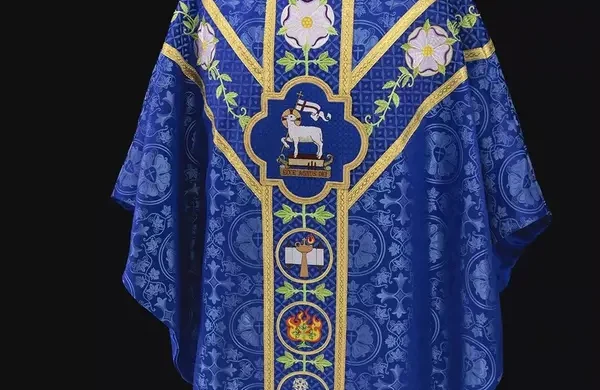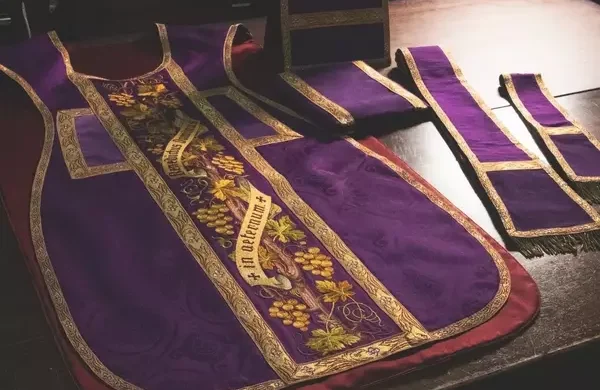
The Te Deum, an ancient hymn of praise, has been a cornerstone of Christian worship for centuries. Recently, Historic Trinity Church in Detroit commissioned a stunning custom Te Deum set from Ecclesiastical Sewing. Crafted from white Luther Rose brocade, the set features intricate symbols that enhance the church’s Gothic Revival architecture, showcasing exceptional artistry while honoring the hymn’s deep spiritual legacy.
Like this:
Like Loading...

Whether you’re an experienced seamstress or just beginning your journey, our intuitive patterns will guide you step-by-step, ensuring your garments are not only visually striking but also deeply meaningful. Join us in preserving a legacy of craftsmanship and devotion, and learn how to breathe life into your fabric with elegance and style. Plus, take advantage of our exclusive discount code for your next pattern order!
Like this:
Like Loading...

Get ready for something BIG! On October 29th, enjoy a 24-hour secret sale on our best-selling Embroidery Design Book. This ultimate crafting resource is perfect for sewing, quilting, and embroidery enthusiasts alike. Packed with designs and inspiration, it’s the ideal gift for creative souls or a treat for yourself. Don’t miss out on 25% off—mark your calendars!
Like this:
Like Loading...

As the busy holiday season approaches, now is the perfect time to place your Christmas orders for altar linens, vestments, and church decorations. While Advent may already be fully booked, planning ahead for next year is essential. Additionally, it’s never too early to start thinking about Lent and Easter projects to avoid last-minute stress. Don’t hesitate to reach out for assistance with fabric choices or design ideas—secure your order today to ensure your church is beautifully prepared for these important liturgical seasons.
Like this:
Like Loading...

Explore the significance of the Ecce Agnus Dei chasuble, beautifully crafted in Luther Rose brocade. This unique blue garment features the powerful motif of the Lamb of God, symbolizing the essence of Advent. Adorned with intricate O Antiphon symbols, it encapsulates the anticipation of Christ’s coming and the fulfillment of prophecy. Perfect for the Advent season, this chasuble merges tradition and artistry, inviting deeper reflection on our faith.
Like this:
Like Loading...

Celebrate Pastor Appreciation Month by gifting your Pastor or Priest a new stole at a rare 10% discount. Handmade in the US from high-quality European fabrics, these stoles enhance their appearance and symbolize your gratitude for their dedicated service. Act fast—this exclusive offer ends on October 31st! Gather your congregation to give a meaningful gift that honors their calling.
Like this:
Like Loading...

Explores the life and legacy of Saint Charles Borromeo, highlighting his commitment to preserving sacred traditions within the Catholic Church during a transformative period. His influence continues to inspire those who value the importance of tradition in faith.
Like this:
Like Loading...

Struggling to find the perfect holiday gift for the special women in your life? Our faith-based jewelry collection offers meaningful, personal gifts that reflect love and care. Enjoy 33% off, plus an additional 10% with code GIFT10. With over 10,000 happy customers and glowing reviews, you can trust us to help make this Christmas unforgettable!
Like this:
Like Loading...

The Luther Rose is a powerful symbol of faith, designed by Martin Luther in the 1500s. It represents core Christian teachings—faith in Christ, peace, joy, and eternal blessings. As we celebrate Reformation Month, limited edition Luther Rose mugs are being released, making it the perfect time to reflect on its significance and legacy.
Like this:
Like Loading...

The pink (or rose) vestments worn by priests on Gaudete Sunday (Advent) and Laetare Sunday (Lent) mark joyful moments in these otherwise reflective seasons. They symbolize hope and celebration, reminding us that Christ’s arrival is near. This tradition, rooted in the 11th century, serves as a visual reminder to rejoice during spiritual preparation.
Like this:
Like Loading...

Get ready for a stress-free Advent and Christmas with our custom vestments. Plan ahead this fall to ensure your church is beautifully prepared for the sacred season.
Like this:
Like Loading...

The “MB” monogram, standing for Mater Beatissima or Blessed Mother, symbolizes Mary’s grace and faith, dating back to the Middle Ages.
Like this:
Like Loading...

Orphrey bands are decorative strips of fabric, often made from gold thread or silk, sewn onto church vestments like stoles, chasubles, and altar cloths. These bands add beauty and symbolize the importance of the garment. For instance, a priest’s stole typically has two orphrey bands, signifying full sacramental authority, while a deacon’s stole has one, reflecting their different role. On special occasions, more bands may be used to enhance the garment’s festivity. Beyond aesthetics, orphrey bands carry historical and symbolic significance in liturgical attire.
Like this:
Like Loading...

Cope, a liturgical vestment worn in Christian denominations such as the Roman Catholic, Anglican, and Lutheran churches. It traces the cope’s origins from Roman cloaks to its evolution into a ceremonial garment by the 9th to 13th centuries. Made from luxurious fabrics and adorned with religious symbols, the cope is typically worn during non-Eucharistic services like processions. Its color changes with the liturgical calendar, symbolizing clergy authority and the Church’s long-standing traditions.
Like this:
Like Loading...

For Pastor Appreciation Month, we’re offering 10% off all stoles for the first time ever with code PASTOR10. This limited-time sale runs until the end of October, so don’t miss your chance to grab a handcrafted stole at a discounted price.
Like this:
Like Loading...
















You must be logged in to post a comment.